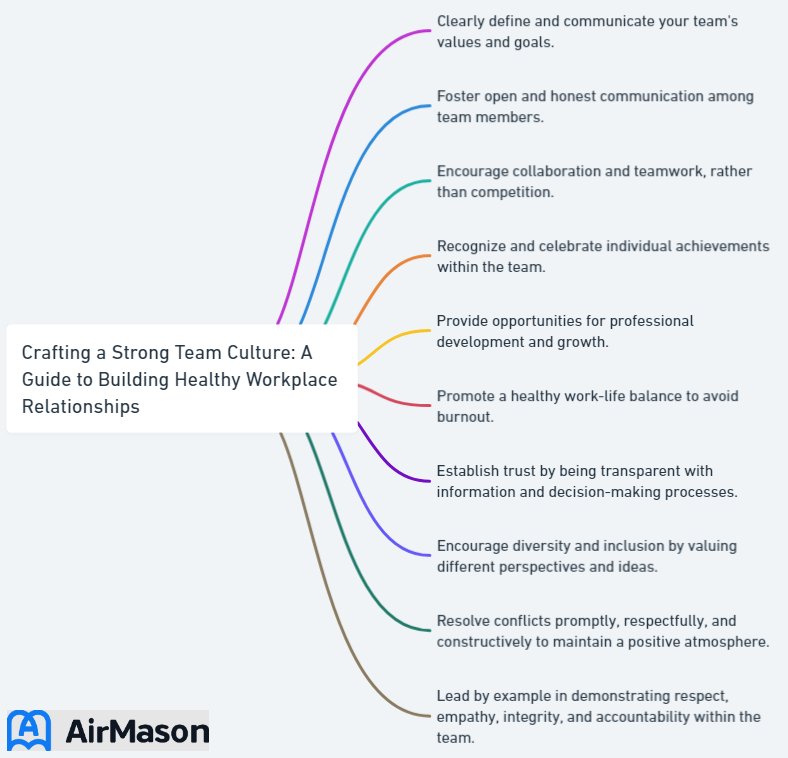
Imagine a workplace where trust, inclusivity, and personal growth are valued and cultivated every day. A place where team members collaborate effortlessly, communicate openly, and genuinely care about one another’s success. This is the power of a strong team culture, and it’s within your reach, whether you’re leading a small team or an entire organization. In this blog post, we’ll explore the essential elements of a healthy team culture and share proven strategies for building an environment where everyone can thrive.
Get ready to embark on a journey where you’ll discover the foundations of successful team cultures, the importance of leadership, and practical tips for fostering trust, inclusivity, and personal development. You’ll also learn how to overcome challenges in team culture, like conflict resolution and adapting to change, and draw inspiration from real-world examples of thriving organizations. Let’s build a winning team culture together!
Key Takeaways
- Unite your team through shared values, trust and respect to create a successful workplace.
- Invest in personal & professional development for growth and motivation.
- Implement effective communication, goal setting & team building activities to foster an inclusive environment that drives performance.
The Essence of Team Culture
A healthy team culture is the foundation of a successful workplace, encompassing shared values, attitudes, and behaviors that drive collaboration and performance. Creating a team culture involves:
- Uniting the employees of an organization through shared values, attributes, and beliefs
- Fostering an environment of trust, respect, and open communication
- Encouraging collaboration and teamwork
- Recognizing and celebrating individual and team achievements
- Providing opportunities for professional growth and development
A good team culture that engages employees can have a hugely positive impact on a company’s team performance, making team culture important. Fostering a strong company culture is essential to achieving this great team culture, which ultimately leads to a great company culture.
The foundations of building a great team culture remain the same regardless of whether you’re working remotely or in person. Creating an environment where employees feel valued, motivated, and inspired to work towards a common goal involves emphasizing trust, inclusivity, and personal and professional development. We will further investigate these vital components and provide actionable strategies for enhancing team culture in the subsequent sections.

An Organization’s Culture
An organization’s culture encompasses the shared values, beliefs, and behaviors that shape its work environment. It serves as the foundation upon which every decision, interaction, and initiative is built. This culture is not a static entity; rather, it evolves over time, influenced by leadership, employees, and external factors. An organization’s culture can be observed in the way teams collaborate, handle challenges, and celebrate successes. It sets the tone for how individuals within the organization relate to one another, as well as to clients or customers. A strong and positive organizational culture fosters employee satisfaction, enhances productivity, and ultimately contributes to the overall success and longevity of the organization.
Defining Team Culture
A team’s culture is truly unique, a combination of team values, beliefs, and practices that come together to help a group of individuals work together to achieve amazing goals. It entails shared values, attributes, and beliefs that unite the team members of an organization.
A competitive team culture can be established by focusing on competing with market or business competitors instead of competing internally against each other. Maintaining a strong organizational culture becomes simpler when the team consists of individuals who embody the skills and values that the organization aspires for. This approach fosters a winning team culture that drives success.
The Role of Leadership in Shaping Team Culture
Leadership plays a crucial role in establishing and maintaining a healthy team culture by setting the tone, modeling desired behaviors, and supporting team members. Leaders can set an example for the team culture they want to create by actively engaging with team members, staying on top of deadlines, and delegating tasks in a way that encourages a positive team culture.
Painting a vivid picture of what the team needs to do to reach success helps motivate team members at the start of a new project. Leaders can cultivate an environment that empowers employees to take ownership of their work and contribute to the team’s success through the provision of resources, support, and guidance.
Building Blocks of a Healthy Team Culture
A healthy team culture is built on trust, inclusivity, and a focus on personal and professional development. Building trust, fostering inclusivity, and emphasizing personal and professional development are essential components for a healthy team culture. In this section, we’ll explore each of these building blocks in more detail and discuss how they contribute to a thriving, high-performing team.
Creating a positive team culture requires a focus on these crucial elements to ensure employees feel valued, motivated, and inspired to build a strong team that can work together towards a common goal. By building a team culture, we will further explore each building block and their contributions to your team’s success.
Trust and Psychological Safety
Trust is essential for creating an environment of open communication, collaboration, and innovation that will help your team reach its fullest potential. Psychological safety plays an essential role in establishing an equitable environment where team members feel comfortable to share ideas and collaborate to tackle challenges.
Creating an environment of trust within our team involves open and honest communication, consistent and reliable behavior, and mutual respect. Fostering a supportive and inclusive environment where everyone’s contributions are valued will help to further strengthen trust within the team.
Inclusivity and Diversity
Inclusivity and diversity promote a sense of belonging and encourage the sharing of different perspectives, leading to better decision-making and problem-solving. An inclusive team culture can be created by emphasizing diversity, equity, and inclusion in our people strategy. When we feel like we belong, we can reach our peak performance, which is essential for successful teamwork.
Including diverse viewpoints in decision-making can bring numerous benefits to teams, such as:
- Introducing unconventional ideas
- Accessing a wider range of talent
- Increasing engagement and trust
- Fostering creativity and innovation
- Honing problem-solving skills
- Carefully processing information
Personal and Professional Development
Supporting personal and professional development helps team members grow, stay engaged, and contribute to the overall success of the organization. Personal and professional development can have a huge impact on a team’s success. By improving skills and job performance, team members can feel more satisfied with their work and be more motivated to reach the team’s goals.
To foster a culture of continuous learning and development in our team, we can:
- Implement a learning management system
- Highlight learning experiences
- Identify skill gaps
- Promote collaboration
- Supply resources for learning
- Acknowledge and reward learning efforts
- Set concrete goals and a learning strategy.
Collaborate Effectively
To collaborate effectively, it’s essential to establish clear communication channels and set defined objectives from the outset. This ensures that all team members are aligned with the project’s goals and understand their respective roles. Moreover, fostering a culture of trust and mutual respect among collaborators creates a conducive environment for open dialogue and idea-sharing. Regular check-ins and progress updates help keep everyone on the same page, allowing for adjustments and realignment as needed. Additionally, leveraging collaborative tools and technology platforms can streamline workflows and facilitate seamless information exchange, regardless of geographical distances. Remember, effective collaboration isn’t just about working together, but about working harmoniously towards a common goal, utilizing each team member’s strengths to achieve the best possible outcome.
Strategies for Enhancing Team Culture

Implementing strategies such as effective communication, goal-setting, and team-building activities can enhance team culture and drive performance. By putting these strategies into practice, you can create an environment that fosters trust, improves communication, reduces potential conflict, and promotes collaboration, all of which are critical for a successful team culture.
We will delve into each strategy in greater detail in the sections to come, offering actionable tips and guidance to foster a thriving, high-performing team culture that bolsters your organization’s success.
Effective Communication
Clear and open communication helps to build trust, align team members, and ensure everyone is working towards the same objectives. Open and clear communication can help build trust, get everyone on the same page, and ensure everyone is working towards the same goals. To ensure effective communication in our team, it is important to practice clear judgment, good listening skills, honesty, engagement, openness, transparency, respect for all opinions, defined roles, two-way feedback, active listening, and clear messaging.
Poor communication can lead to a lack of predictability and stability in the workplace, mistrust among employees, absenteeism, reduced morale, strained interpersonal relationships, and difficulty in working together cohesively and productively as a team. Leaders can cultivate an atmosphere of open and effective communication within their team by being transparent, treating everyone with respect, and investing in employees’ goals, staying in touch frequently, listening attentively, recognizing the value of employees’ opinions, requesting honest feedback, and actively encouraging open communication.
Goal-Setting and Performance Recognition
Setting goals and recognizing team members’ achievements fosters motivation, accountability, and a sense of accomplishment. Goal setting can create an environment of engagement, motivation, inspiration, and collaboration. Plus, it helps team members align with the company’s values and mission, which sets the tone for their attitudes and work ethic.
Performance recognition is crucial for motivating and engaging employees, fostering collaboration, and reinforcing the company’s values and mission. By openly discussing differing viewpoints and resolving conflicts cooperatively, it can help foster a sense of unity, shared purpose, and mutual respect within the team. This leads to improved morale, increased productivity, and stronger relationships among team members.
Team-Building Activities
Team-building activities can:
- Strengthen relationships
- Improve communication
- Promote collaboration among team members
- Foster collaboration
- Deepen understanding
- Boost morale and motivation
Why not give Zoom happy hours or virtual cooking classes a try? These are great icebreakers before beginning your meeting. These fun and engaging activities can bring your team closer together, enhance communication, and foster a sense of camaraderie and unity that contributes to a positive team culture.
Overcoming Challenges in Team Culture

Addressing challenges in team culture, such as conflict resolution, toxic work environments, and adapting to change, is crucial for maintaining a healthy and productive workplace. Opportunities for growth in team culture can include conflict resolution, fostering a healthy work environment, and embracing change.
We will further explore each of these challenges in the upcoming sections and discuss effective navigation strategies. By facing these challenges head-on and implementing strategies to overcome them, you can ensure that your team culture remains strong, resilient, and adaptable in the face of any obstacles that may arise.
Conflict Resolution
Effective conflict resolution strategies can help teams navigate disagreements, maintain trust, and foster a positive work environment. Conflict resolution is a powerful tool for resolving disputes between team members and fostering a healthy and productive workplace.
Teams can effectively resolve conflicts by:
- Keeping communication open and clear
- Listening to each other
- Focusing on the problem rather than the individuals involved
- Identifying points of agreement and disagreement
- Developing a solution that meets the common goal
By practicing these strategies, you can create an environment where conflicts are addressed constructively and resolved in a way that strengthens team dynamics and fosters a positive team culture.
Identifying and Addressing Toxic Work Environments
Identifying and addressing toxic work environments is essential for protecting employee well-being and ensuring a healthy team culture. Be aware of the following signs of a toxic work environment:
- High turnover rates
- Inadequate training and support
- Disrespectful and discriminatory behavior
- Distrust among colleagues
- A generally hostile atmosphere
Addressing these issues is crucial for creating a positive and productive work environment in the long term.
Creating a positive work environment is essential for employees to feel safe, valued, and supported. Addressing a toxic work environment is important to promote productivity, reduce stress, and build trust among team members. By focusing on trust, open communication, and employee development, you can create a positive and supportive atmosphere that fosters a healthy and successful team culture.
Adapting to Change
Adapting to change, such as organizational restructuring or remote work, requires flexibility, open communication, and support from leadership. Adapting to change is an essential process for any team to stay agile and responsive to new situations or circumstances.
Creating an environment of adaptability, communicating expectations clearly, and involving team members in the transition process can help your team quickly and effectively adjust to changes in the workplace, thereby promoting a successful team culture. By embracing change and staying flexible, your team can continue to grow and thrive, even in the face of unexpected challenges or shifting circumstances.
How to Stay Positive at Work
Maintaining a positive outlook in the workplace is crucial for overall productivity and well-being. To effectively navigate the challenges of a professional environment, understanding how to stay positive at work is key. Firstly, it’s important to cultivate a growth mindset, viewing obstacles as opportunities for personal and professional development. Acknowledging achievements, no matter how small, can significantly boost morale. Additionally, fostering open communication with colleagues and supervisors can create a supportive atmosphere that encourages positivity. Engaging in regular breaks and incorporating mindfulness techniques can help alleviate stress and promote a more optimistic mindset throughout the workday. Lastly, finding meaning and purpose in your work, whether through aligning tasks with personal values or contributing to a larger mission, can provide a powerful source of motivation and positivity.
Real-World Examples of Successful Team Cultures

Learning from real-world examples of successful team cultures can provide valuable insights and inspiration for building a strong team culture within your own organization. Here are some examples that showcase the power of:
- Trust
- Open communication
- Inclusivity
- Personal and professional development
These factors, reflecting the core values, are essential in fostering a thriving, high-performing team culture for every team member.
In the subsequent sections, we will examine two real-world examples of thriving team cultures at Company A and Company B. An examination of their strategies and values offers inspiration and practical tips for fostering a successful team culture within your own organization.
Company A
Based on the provided text, I have split it into paragraphs:
Paragraph 1: Company A demonstrates the importance of trust, open communication, and employee development in fostering a high-performing team culture. At Company A, trust, open communication, and employee development are the cornerstones of a thriving team culture.
Company A emphasizes the significance of trust, open communication, and employee development to achieve a successful team culture. By focusing on these key elements, Company A has created a positive and supportive environment where employees can collaborate effectively, communicate openly, and reach their full potential by working with one another.
Company B
Company B showcases the benefits of prioritizing inclusivity, diversity, and innovation in creating a thriving and successful team culture. At Company B, inclusivity, diversity, and innovation are the driving forces behind their successful team culture.
Company B actively encourages creativity and values ideas by:
- Giving employees experiential learning experiences
- Creating an atmosphere of trust and psychological safety
- Providing resources for innovation
- Empowering employees to experiment and collaborate on projects
These efforts ultimately foster a culture of innovation within the company.
Summary
In conclusion, building a strong team culture is essential for creating a successful workplace that fosters collaboration, innovation, and high performance. By focusing on trust, inclusivity, and personal and professional development, you can create an environment where employees feel valued, motivated, and inspired to work together towards a common goal.
Remember, the journey towards a thriving team culture is a continuous process that requires commitment, adaptability, and open communication. By implementing the strategies and insights shared in this blog post, you’ll be well on your way to building a winning team culture that supports the success of your organization and empowers your team members to reach their full potential.
Frequently Asked Questions
What is successful team culture?
Successful team culture is built on aligning members around a purpose and empowering them to work together while still giving autonomy to each individual. This builds trust, allowing teams to operate effectively and flexibly towards their shared goals.
What are the qualities of team culture?
Team culture is based on having a common purpose, shared organizational values, and understanding of roles. It is further strengthened by incentives, recognition, and support. Such an environment enables teams to thrive and achieve maximum success.
What is a team culture statement?
A team culture statement is a short, inspiring statement that outlines what an organization does, who it serves and what it aims to achieve. It defines the mission, values and codes of conduct, providing employees with a guide to refer to and reinforcing their role in the company and its long-term goals.
What is positive team culture at work?
A positive team culture creates an atmosphere of collaboration, trust and productivity that leads to high employee engagement and satisfaction. It reflects a strong team dynamic, clear values and a path for growth, all of which are key indicators of an organisation’s success.
How can effective communication foster a strong team culture?
Effective communication can create a sense of trust and understanding, promote collaboration, and ensure everyone is working towards the same objectives, creating a strong team culture.
